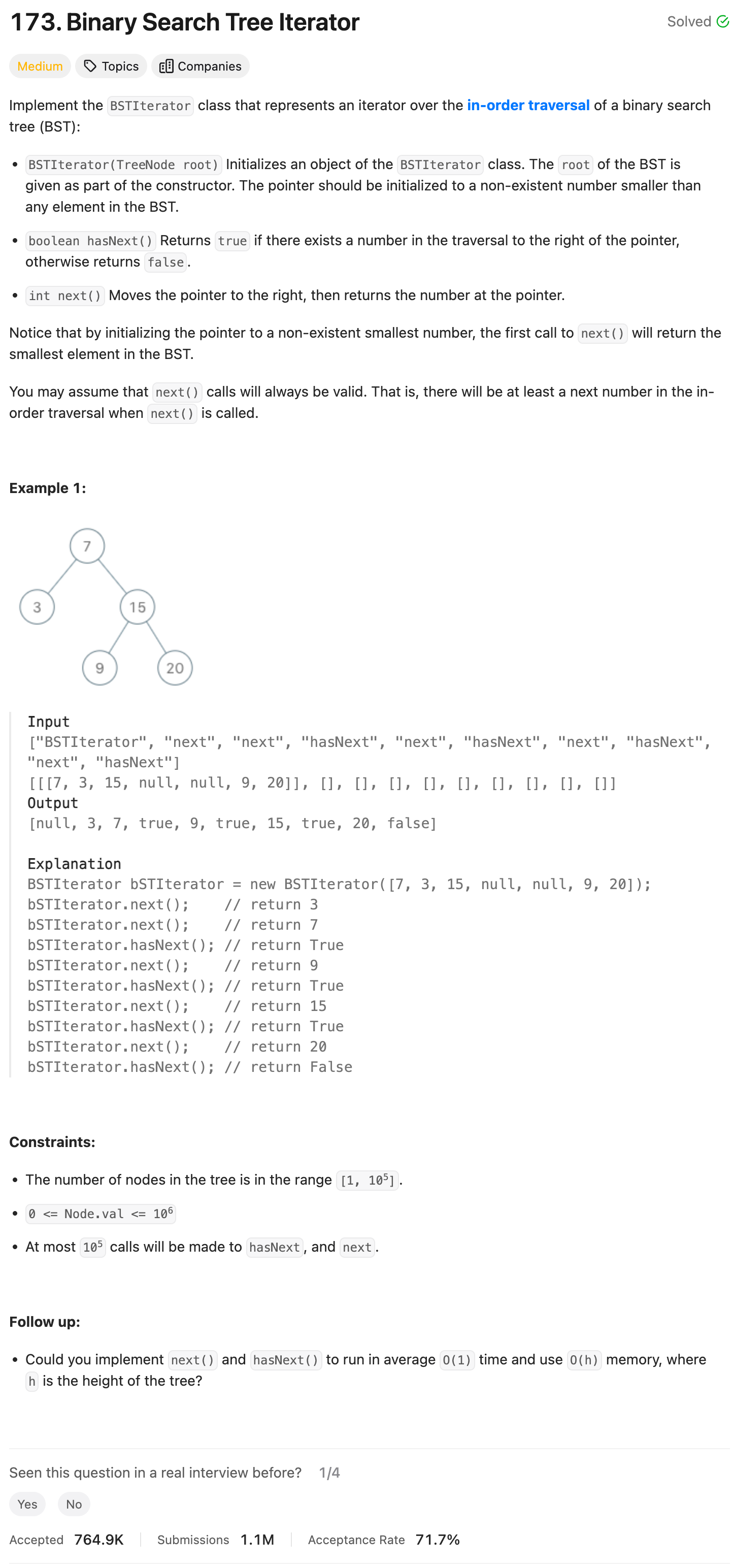Problem of The Day: Binary Search Tree Iterator
Problem Statement
Intuition
My approach involves converting the binary search tree into a singly linked list using an in-order traversal. This conversion allows for efficient retrieval of the next element and checking for its existence.
Approach
- Initialize a dummy node to facilitate the conversion process.
- Perform an in-order traversal of the binary search tree.
- During traversal, modify the tree nodes to form a linked list such that each node’s right child points to the next node in the traversal sequence.
- Adjust the current pointer accordingly to maintain track of the current node during traversal.
- Implement
next()method to move to the next node in the traversal sequence and return its value. - Implement
hasNext()method to check if there exists a next node to traverse.
Complexity
-
Time complexity:
- Initializing the iterator involves an in-order traversal of the entire tree, which takes O(n) time, where n is the number of nodes in the BST.
- Both
next()andhasNext()methods have O(1) time complexity as they involve simple pointer manipulation.
-
Space complexity:
- The space complexity of the
BSTIteratorclass is O(n), where n is the number of nodes in the BST, as we store all nodes in the dummy node during initialization. - The space complexity of the
next()andhasNext()methods is O(1) since we are not using any additional space proportional to the input size.
- The space complexity of the
Code
# Definition for a binary tree node.
# class TreeNode:
# def __init__(self, val=0, left=None, right=None):
# self.val = val
# self.left = left
# self.right = right
class BSTIterator:
def __init__(self, root: Optional[TreeNode]):
self.dummy = TreeNode(-1)
self.curr = self.dummy
self.in_order_traverse(root)
self.curr = self.dummy
def in_order_traverse(self, root):
if not root:
return
self.in_order_traverse(root.left)
self.curr.right = root
self.curr = self.curr.right
self.in_order_traverse(root.right)
def next(self) -> int:
self.curr = self.curr.right
return self.curr.val
def hasNext(self) -> bool:
return True if self.curr and self.curr.right else False
# Your BSTIterator object will be instantiated and called as such:
# obj = BSTIterator(root)
# param_1 = obj.next()
# param_2 = obj.hasNext()
Editorial Solution
Approach 1: Flattening the BST
# Definition for a binary tree node.
# class TreeNode:
# def __init__(self, x):
# self.val = x
# self.left = None
# self.right = None
class BSTIterator:
def __init__(self, root: TreeNode):
# Array containing all the nodes in the sorted order
self.nodes_sorted = []
# Pointer to the next smallest element in the BST
self.index = -1
# Call to flatten the input binary search tree
self._inorder(root)
def _inorder(self, root):
if not root:
return
self._inorder(root.left)
self.nodes_sorted.append(root.val)
self._inorder(root.right)
def next(self) -> int:
"""
@return the next smallest number
"""
self.index += 1
return self.nodes_sorted[self.index]
def hasNext(self) -> bool:
"""
@return whether we have a next smallest number
"""
return self.index + 1 < len(self.nodes_sorted)
Approach 2: Controlled Recursion
# Definition for a binary tree node.
# class TreeNode:
# def __init__(self, x):
# self.val = x
# self.left = None
# self.right = None
class BSTIterator:
def __init__(self, root: TreeNode):
# Stack for the recursion simulation
self.stack = []
# Remember that the algorithm starts with a call to the helper function
# with the root node as the input
self._leftmost_inorder(root)
def _leftmost_inorder(self, root):
# For a given node, add all the elements in the leftmost branch of the tree
# under it to the stack.
while root:
self.stack.append(root)
root = root.left
def next(self) -> int:
"""
@return the next smallest number
"""
# Node at the top of the stack is the next smallest element
topmost_node = self.stack.pop()
# Need to maintain the invariant. If the node has a right child, call the
# helper function for the right child
if topmost_node.right:
self._leftmost_inorder(topmost_node.right)
return topmost_node.val
def hasNext(self) -> bool:
"""
@return whether we have a next smallest number
"""
return len(self.stack) > 0
